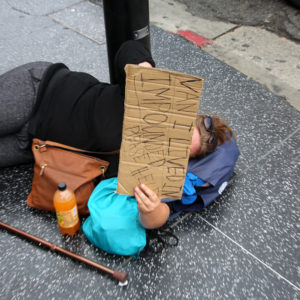For an alternate viewpoint, see “Point: Housing Alone Cannot Solve Homelessness.”
Homelessness in the United States surged by a record 12 percent between January 2022 and January 2023, according to a new report by the Department of Housing and Urban Development. In the world’s wealthiest nation, how does this happen, and what can be done to remedy it?
The primary reason people are homeless is straightforward: they can’t afford a place to live.
This crisis isn’t new. For decades, affordable housing supply has failed to keep pace with demand. And the minimum wage has not kept pace with the rising cost of living and inflation over the last 50 years.
According to a report by the National Low-Income Housing Coalition, every state in the country needs a sufficient supply of affordable housing. They found a shortfall of more than 7 million affordable rental units for people at or below the poverty level or for whom rent would consume more than 30 percent of their income.
The pandemic laid this crisis bare — but it also showed us solutions.
In the first year of the COVID-19 pandemic, the Consumer Financial Protection Bureau found there were 2 million households who were at least three months behind in their mortgage — an increase of 250 percent from the prior year — and more than 8 million renters behind on their rent.
Lower-income Americans of all races were affected, but the risk of losing housing fell disproportionately on Black and Latinx communities, which had lower levels of wealth and home ownership before the pandemic due to a history of systemic racism. They were also more likely to lose employment during the lockdowns in 2020.
Fortunately, lawmakers responded to the pandemic by expanding the social safety net. Alongside income supports like stimulus payments, expanded unemployment, and the expanded Child Tax Credit, they imposed eviction moratoria and emergency rental assistance programs.
These measures worked — many lower-income families could stay housed, and homelessness actually dropped. But unfortunately, the measures were temporary. When they lapsed, homelessness shot right back up by a record amount.
While the economic effects of the pandemic have eased, the causes of the housing crisis remain. According to the National Low-Income Housing Coalition, about half of all U.S. workers can’t afford a one-bedroom rental anywhere — and a full-time worker making minimum wage can’t afford a two-bedroom rental anywhere.
I spoke with Kim Johnson, the organization’s manager of public policy.
“The U.S. has never invested enough in the long-term solutions we know help prevent and end homelessness,” Johnson said. “At current funding levels, only an estimated one in four households whose income qualifies them for housing assistance actually receive it, leaving the other 75 percent of households to spend over 30 percent — and for many of the lowest-income households, over 50 percent — of their income on rent and utilities every month.”
These households are often just one missed paycheck or unexpected bill away, Johnson said, from missing rent payments, facing eviction, or falling into homelessness.
So what can be done?
First, we must invest in affordable housing for those with the lowest incomes. We have to invest in upkeep and repairs. It’s not enough to build it and forget it. Housing stock must be maintained to be livable.
Congress should fully fund the Tenant-Based Rental Assistance program, which assists low-income renters with funds for housing needs. Resources must also help fight unnecessary evictions and keep families in their homes. We must invest in a permanent Emergency Rental Assistance Program and include housing grants for communities with the greatest need. And the Housing Choice Voucher program must be fully funded.
We also need a livable “housing wage” of $28.58 per hour so that full-time minimum-wage workers can afford a modest two-bedroom rental unit.
Safe, stable, affordable housing is foundational to a healthy, productive society. It improves children’s educational attainment and physical, behavioral and mental health. It helps adults get and maintain better-paying jobs, improves their health outcomes and builds wealth.
A securely housed population benefits our whole society. Housing should be considered a human right for all, not just a privilege for some. We know what to do. Now, let’s do it.

